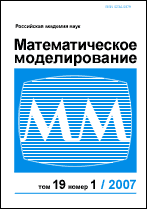|
This article is cited in 9 scientific papers (total in 9 papers)
The verification of the calculation of stationary subsonic flows and the presentation of results
V. V. Vyshinskyab, G. B. Sizykha
a Moscow Institute of Physics and Technology (State University)
b Central Aerohydrodynamic Institute named after prof. N.E. Zhukovskiy
Abstract:
The principle of pressure maximum is proved for a stationary three-dimensional vortex flow of an ideal gas (without the assumption of barotropicity). Based on the fact that in areas where the solution with high accuracy modeled by the Euler equations must be fulfilled and consequences of these equations, obtained subsonic principle is proposed to be used for verification of numerical solutions of boundary value problems for Euler equations for an ideal gas and for the Navier–Stokes equations for viscous gas. Conditions of the maximum principle include the value of the $Q$-parameter, image surface level of which is currently widely used to visualize the flow pattern. The proposed principle of maximum pressure reveals the meaning of the surface $Q=0$. It divides the flow region into the subdomain $Q>0$, which cannot has a local pressure maximum points, and subdomain $Q<0$ which cannot has a local pressure minimum points. A similar meaning of the parameter $Q$ was known for incompressible fluid (H. Rowland, 1880; G. Hamel, 1936). The expression for the $Q$-parameter contains only the first derivatives of the components of the velocity, which allows determining the sign ($+/–$) of $Q$ even for numerical solutions obtained by the methods of low order. An example of the numerical solution verification using subsonic maximum pressure principle is presented. Analysis of the results of numerical calculation of the flow around the aircraft carrier ship during its movement and the presence of atmospheric winds showed that if the calculation results are used for the simulation of complex flight modes and to analyze the state of the atmosphere from the point of view of safe air traffic, visualization the flow pattern by $Q=\mathrm{const}$ surfaces is not informative. In particular, these surfaces do not reflect the true picture of the wind shear, which is perceived directly falls into a flying vehicle. To verify the numerical method, it is sufficient to provide only a surface $Q=0$, which has a clear physical meaning.
Keywords:
Euler equations, Navier–Stokes equations, subsonic vortex flows, subsonic principle of pressure maximum, correctness of problems, forms of calculation results presentation, verification of calculation results.
Received: 19.04.2017
Citation:
V. V. Vyshinsky, G. B. Sizykh, “The verification of the calculation of stationary subsonic flows and the presentation of results”, Matem. Mod., 30:6 (2018), 21–38; Math. Models Comput. Simul., 11:1 (2019), 97–106
Linking options:
https://www.mathnet.ru/eng/mm3974 https://www.mathnet.ru/eng/mm/v30/i6/p21
|

|




 Contact us:
Contact us: Terms of Use
Terms of Use
 Registration to the website
Registration to the website Logotypes
Logotypes








 Citation in format
Citation in format 
